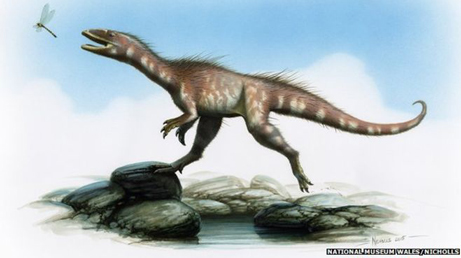A New Dinosaur Called Pendraig milnerae – “Chief Dragon”
Scientists have described the oldest theropod dinosaur from the UK. The dinosaur has been named Pendraig milnerae, the scientific name honours the dinosaur’s Welsh roots and recognises the contribution of Dr Angela Milner, who sadly passed away last August.
Everything Dinosaur recently blogged about the naming of two spinosaurids described from fragmentary fossils found on the Isle of Wight. The trivial name of one of these theropods, Riparovenator milnerae, also honours Dr Milner.
To read Everything Dinosaur’s recent blog post about the two newly described spinosaurids: Two New Spinosaurids from the Isle of Wight.
Ironically, the remains of Pendraig were already ancient fossils when the Isle of Wight spinosaurids roamed. The Pendraig fossils come from limestone fissure fills of the Pant-y-ffynnon Quarry in the Vale of Glamorgan (Wales). This infilled material, deposited in Carboniferous limestone is difficult to date, but it is thought that these fossils are between 215 and 201 million years old (late Norian, latest occurrence possibly late Rhaetian).

Misplaced Theropod Fossils
Writing in Royal Society Open Science, the researchers from the London Natural History Museum, the University of Birmingham and National Museums Scotland describe Pendraig milnerae based on an articulated pelvic girdle, sacrum and posterior dorsal vertebrae, and an associated left femur and by two referred specimens, comprising an isolated dorsal vertebra and a partial left ischium.
Co-author of the paper, Dr Susannah Maidment (London Natural History Museum), explained that the fossil material had been stored in a draw that contained crocodylomorphs. It was Dr Milner who was able to find the fossils within the vast Natural History Museum collection and to retrieve an unpublished PhD paper that had referred to them as part of a wider review of archosaurian remains associated with South Wales.

Welsh Dinosaurs
A phylogenetic analysis indicates that was a P. milnerae non-coelophysid coelophysoid and it represents the first-named, unambiguous theropod from the Triassic of the UK. The genus name translates from Middle Welsh as “chief dragon”. During the Late Triassic, the dinosaurs were not the dominant terrestrial animals that they were later to become. Discoveries of Triassic-aged theropods can help palaeontologists to better understand the evolution of these important tetrapods, the dinosaur lineage that led directly to modern birds.
Wales might be associated with dragons, but dinosaur discoveries are extremely rare in this part of the UK. Previously, only two dinosaur genera have been named – Pantydraco (P. cauducus) a basal sauropodomorph from a limestone fissure infill from the Pant-y-ffynnon Quarry and the coelophysoid Dracoraptor (D. hanigani) which was named and described in 2016 from fossils found near the Welsh town of Penarth.

An Insular Dwarf
The palaeoenvironment in which Pendraig lived was most likely an archipelago and species that live on small islands with limited resources can become smaller than their mainland relatives due to a phenomenon known as insular dwarfism.
Measuring around 75 cm to a metre in length P. milnerae was indeed small, a characteristic that it shares with a number of other vertebrates known from the same deposits.
Lead author of the paper, Dr Stephan Spiekman (London Natural History Museum), explained:
“Because the fossil reptiles from this area, including Pendraig, are all quite small-sized, we used statistical analyses to investigate whether Pendraig might have been an insular dwarf. The results indicate that Pendraig is indeed small, even for a theropod of that time period, but not uniquely so”.
Analysis of the fossil bones, indicate that the material does not represent a juvenile or very young animal. However, the fossils do represent an animal that was probably not fully grown when it died.

The researchers conclude that Pendraig may have been a dwarf form but as some other coelophysoid taxa also show a similar size reduction (based on femur bone length comparisons), it is not possible to say with certainty that this little Welsh, Triassic dinosaur was indeed an insular dwarf.
Dr Spiekman added:
“With this in mind, we need more evidence from more species to investigate the potential for island dwarfism in this area during that time, but if we could prove it, it would be the earliest known occurrence of this evolutionary phenomenon”.
The scientific paper: “Pendraig milnerae, a new small-sized coelophysoid theropod from the Late Triassic of Wales” by Stephan N. F. Spiekman, Martín D. Ezcurra, Richard J. Butler, Nicholas C. Fraser and Susannah C. R. Maidment published in Royal Society Open Science.
Visit the Everything Dinosaur: Dinosaur Toys.

